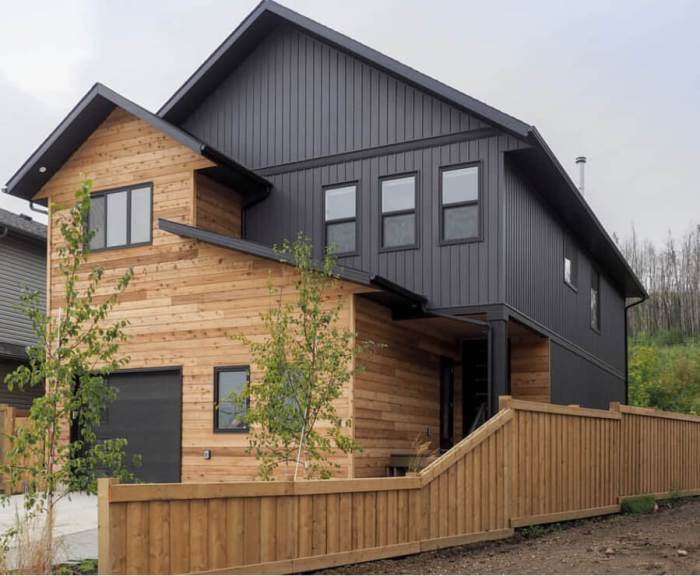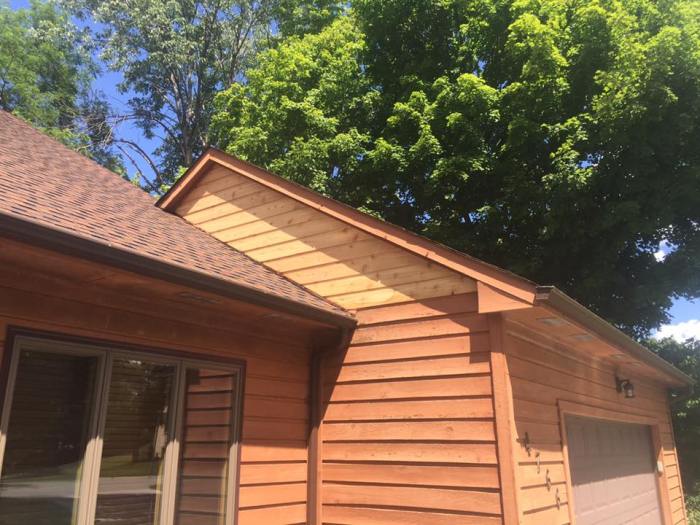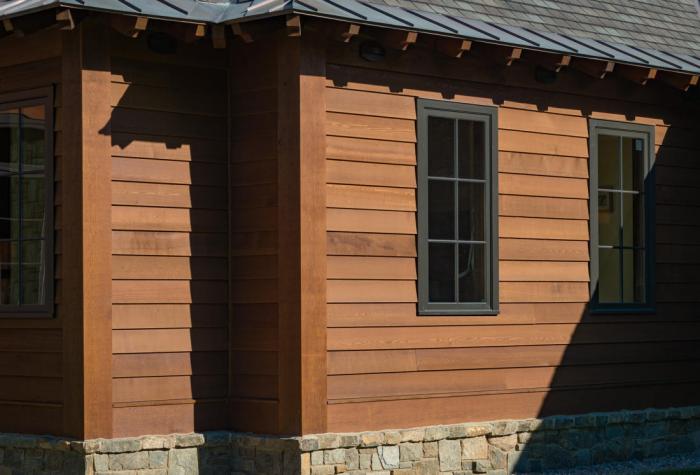Cedar siding near me? Finding the right supplier for your project is crucial. This guide explores local cedar siding options, detailing costs, maintenance, styles, and environmental considerations. We’ll help you navigate the process from choosing the perfect type of cedar siding—like Western Red Cedar or Eastern White Cedar—to understanding installation costs and long-term maintenance needs. Whether you’re looking for bevel siding, channel siding, or clapboard, we’ll cover the aesthetic appeal and practical aspects of each, ensuring your project is both beautiful and sustainable.
From comparing prices per square foot for different grades to exploring the environmental impact of your choice, we’ll equip you with the knowledge to make informed decisions. We’ll also discuss the specialized services offered by local suppliers, such as installation, design consultation, and delivery, helping you find a seamless and stress-free experience. Let’s dive into the world of cedar siding and find the perfect fit for your home.
Local Cedar Siding Suppliers

Finding the right cedar siding supplier is crucial for any home renovation or construction project. The quality of the cedar, the variety available, and the level of service offered can significantly impact the final outcome and your overall budget. Choosing a reputable supplier ensures you receive high-quality materials and potentially valuable support throughout the process. This section provides information on several local cedar siding suppliers, detailing their offerings and services.
Cedar Siding Supplier Information
The following table lists five example local cedar siding suppliers. Note that this is not an exhaustive list, and the availability and specifics of these suppliers may vary depending on your location. Always verify information directly with the supplier before making any decisions. The information provided below is for illustrative purposes only and should not be considered a complete or definitive guide.
| Name | Address | Phone Number | Website |
|---|---|---|---|
| Acme Lumber & Supply | 123 Main Street, Anytown, CA 91234 | (555) 123-4567 | www.acmelumber.com (example) |
| Best Cedar Siding Co. | 456 Oak Avenue, Anytown, CA 91234 | (555) 987-6543 | www.bestcedarsiding.com (example) |
| Premium Wood Products | 789 Pine Lane, Anytown, CA 91234 | (555) 555-5555 | www.premiumwood.com (example) |
| Green Valley Lumber | 1011 Willow Street, Anytown, CA 91234 | (555) 111-2222 | www.greenvalleylumber.com (example) |
| Cedar & More | 1213 Maple Drive, Anytown, CA 91234 | (555) 333-4444 | www.cedarandmore.com (example) |
Cedar Siding Types and Services
Each supplier typically offers a range of cedar siding options, including Western Red Cedar and Eastern White Cedar. Western Red Cedar is known for its durability and resistance to decay, while Eastern White Cedar is often favored for its lighter color and workability. Specific types and grades will vary by supplier. Many suppliers offer additional services beyond simply providing the materials. These services can include installation, design consultation to help you choose the right siding for your home, and delivery to your project site. Some may also offer pre-finished siding options, saving you time and effort. Contacting individual suppliers will provide the most accurate information on their specific offerings.
Cedar Siding Costs and Pricing

Cedar siding offers a beautiful and durable exterior cladding option, but the cost can vary significantly depending on several factors. Understanding these factors and the associated pricing is crucial for budgeting your project accurately. This section details the cost breakdown of cedar siding, considering different grades and types, as well as the influence of labor and project complexity.
Cedar Siding Price Comparison
The price of cedar siding is heavily influenced by the grade and type of wood used. Higher grades generally mean straighter, less knotty boards with a more uniform appearance, commanding a higher price. Different cedar species also have varying costs.
| Siding Type | Grade | Price per Square Foot | Notes |
|---|---|---|---|
| Western Red Cedar | Clear | $4.50 – $7.00 | Premium grade with minimal knots and imperfections. |
| Western Red Cedar | Premium | $3.50 – $5.50 | Fewer imperfections than standard grade, but may contain some small knots. |
| Western Red Cedar | Standard | $2.50 – $4.00 | May contain more knots and variations in color and texture. |
| Eastern White Cedar | Premium | $3.00 – $5.00 | Similar quality to Western Red Cedar Premium, but potentially with slightly more knots. |
| Eastern White Cedar | Standard | $2.00 – $3.50 | More variations in color and texture than premium grade. |
*Note: Prices are estimates and can vary based on location, supplier, and market conditions. These figures represent average ranges observed in various regions.*
Factors Influencing Overall Cedar Siding Installation Cost
Several factors contribute to the total cost of a cedar siding project beyond the price of the materials themselves. These include labor costs, project complexity, and necessary permits.
Labor costs are a significant portion of the overall expense. The complexity of the project—such as the size of the house, the presence of intricate architectural details, and the need for extensive repairs or removal of existing siding—will directly impact the labor hours required and therefore the overall cost. For example, a simple, single-story house with a straightforward design will generally require less labor than a multi-story home with dormers, bay windows, and complex trim work. Furthermore, the need for additional services, like removal of old siding or specialized repairs, increases labor expenses.
Material costs, beyond the siding itself, include things like underlayment, flashing, fasteners, and caulking. These supplementary materials contribute to the project’s overall material expense.
Permits are required in most jurisdictions before starting any exterior renovation work. Permit costs vary by location and the scope of the project.
Sample Cedar Siding Project Budget Breakdown
This budget breakdown provides a realistic estimate for a typical 1500 square foot house siding project. These are estimates and should be adjusted based on your specific location, project details, and chosen materials.
| Item | Cost |
|---|---|
| Cedar Siding (Western Red Cedar, Premium Grade) | $4,500 – $7,500 (assuming $3-$5 per sq ft) |
| Underlayment & Flashing | $1,000 – $1,500 |
| Fasteners & Caulking | $500 – $750 |
| Labor (Installation) | $6,000 – $10,000 (depending on complexity and regional labor rates) |
| Permits | $300 – $500 |
| Total Estimated Cost | $12,300 – $20,250 |
*This is a sample budget; actual costs may vary significantly.* It’s essential to obtain multiple quotes from reputable contractors to accurately determine the cost of your specific project. Remember to factor in potential contingencies for unexpected expenses.
Cedar Siding Maintenance and Care
Proper maintenance is crucial for extending the lifespan and preserving the beauty of your cedar siding. Neglecting routine care can lead to premature deterioration, costly repairs, and a diminished aesthetic appeal. Regular cleaning, preventative treatments, and prompt attention to damage are essential for keeping your cedar siding in top condition.
Maintaining cedar siding involves a combination of regular cleaning, preventative treatments, and prompt attention to any signs of damage. This proactive approach helps prevent costly repairs and ensures your siding remains attractive and durable for years to come.
Cleaning and Maintaining Cedar Siding
Regular cleaning removes dirt, debris, and mildew, preventing them from damaging the wood. Different cleaning methods are suitable depending on the level of soiling. A simple cleaning can significantly extend the life of your siding.
- Annual Cleaning: Use a garden hose with a nozzle to rinse away loose dirt and debris. For more stubborn stains, use a soft-bristled brush and a solution of mild detergent and water. Always rinse thoroughly afterwards.
- Mildew Removal: For mildew, use a solution of bleach and water (one part bleach to three parts water). Apply with a soft-bristled brush, let it sit for a few minutes, and then rinse thoroughly. Always test in an inconspicuous area first.
- Pressure Washing: Pressure washing can be effective but should be used cautiously. Too much pressure can damage the wood. Use a low-pressure setting and maintain a safe distance from the siding. Consider hiring a professional for pressure washing.
Common Cedar Siding Problems and Solutions
Cedar siding, while durable, is susceptible to certain problems. Early detection and prompt action are key to preventing extensive damage. Understanding these common issues allows for proactive maintenance and cost-effective solutions.
- Rot: Rot is caused by moisture accumulation. Address this by ensuring proper ventilation, repairing any damaged areas promptly, and applying a water-repellent sealant. Severely rotted sections may need replacement.
- Insect Damage: Insects like termites and carpenter ants can bore into cedar. Regular inspections and preventative treatments with insecticide are crucial. Professional pest control may be necessary for severe infestations.
- Weathering: Exposure to the elements causes cedar to fade and gray. Regular cleaning and the application of a stain or sealant can help protect against weathering and maintain the original color.
Staining and Sealing Cedar Siding
Staining and sealing cedar siding provides protection against the elements and enhances its aesthetic appeal. Choosing the right product and applying it correctly is vital for optimal results. Proper preparation is key to a successful staining or sealing job.
- Preparation: Clean the siding thoroughly to remove dirt, debris, and mildew. Allow the siding to dry completely before applying any stain or sealant.
- Primer (Optional): A primer can improve the stain’s adhesion and enhance color consistency, especially on new or bare wood. Follow the manufacturer’s instructions for application.
- Stain or Sealant Application: Apply the stain or sealant evenly using a brush, roller, or sprayer. Follow the manufacturer’s instructions regarding drying time and application techniques. Multiple thin coats are generally better than one thick coat.
- Maintenance: Reapply stain or sealant every 2-3 years, or as needed, to maintain protection and prevent weathering.
Cedar Siding Styles and Designs: Cedar Siding Near Me
Cedar siding offers a wide array of styles and designs, each contributing unique aesthetic qualities to a home’s exterior. The choice of siding style significantly impacts the overall visual appeal and can complement or contrast with various architectural designs. Understanding the different options allows homeowners to make informed decisions that enhance their property’s curb appeal and value.
Cedar Siding Style Comparison
The following table compares several popular cedar siding styles, highlighting their characteristics and benefits.
| Siding Style | Description | Image Description | Advantages |
|---|---|---|---|
| Bevel Siding | This style features overlapping boards with a beveled edge, creating a classic, slightly shadowed appearance. The bevel creates depth and texture. | Imagine a warm, reddish-brown cedar board with a subtle, angled bevel. The texture is smooth but with visible wood grain. The visual appeal is traditional and elegant, suggesting warmth and rustic charm. | Versatile, cost-effective, easy to install, creates a traditional look. |
| Channel Siding | Characterized by its vertical channels or grooves running the length of each board, giving it a more modern and linear appearance. | Picture a light-colored cedar board with deep, evenly spaced vertical channels. The texture is smooth within the channels but retains the natural wood grain. The visual appeal is clean, contemporary, and sleek. | Modern aesthetic, clean lines, can visually enhance the height of a home. |
| Clapboard Siding | Also known as lap siding, this style uses long, narrow boards that overlap each other significantly, creating a layered effect. | Envision a weathered gray cedar clapboard with varying shades and textures. The overlapping boards create depth and shadow. The visual appeal is classic, traditional, and often evokes a sense of history. | Durable, classic appearance, excellent weather protection, provides good insulation. |
| Shingle Siding | Shingles are individual pieces of cedar, typically thicker than other siding types, that are applied in overlapping rows. They can be hand-split for a more rustic look or machine-sawn for a cleaner finish. | Imagine thick, roughly textured cedar shingles in a dark brown, almost black, color. The visual appeal is rustic, rugged, and often associated with older homes or mountain cabins. The texture is visibly rough and varied. | Durable, visually appealing rustic look, excellent weather protection. Can be more expensive than other styles. |
Cedar Siding and Architectural Design
The aesthetic appeal of different cedar siding styles varies greatly depending on the home’s architectural style. For instance, clapboard siding complements traditional New England homes, while channel siding might be more suitable for contemporary or minimalist designs. Bevel siding offers a versatile option, working well with both traditional and transitional styles. Shingle siding is often used to create a rustic or craftsman-style aesthetic.
Incorporating Cedar Siding into Home Exterior Design
Cedar siding can be incorporated in various ways to create unique and visually stunning exteriors. Using cedar as an accent on gable ends or around windows and doors can add visual interest without overwhelming the entire façade. A full cedar siding application provides a cohesive and natural look. Mixing cedar siding with other materials, such as stone or stucco, can create a sophisticated contrast and add architectural detail. For example, using cedar siding on the upper levels of a home with stone on the lower levels can create a visually striking and balanced exterior. Vertical cedar siding can visually elongate a home, while horizontal siding creates a sense of breadth. The strategic use of different cedar siding styles on various sections of the house can create a dynamic and layered design.
Environmental Considerations of Cedar Siding

Cedar siding, a popular choice for its beauty and durability, also presents a range of environmental considerations. Understanding the sustainability of cedar, its impact compared to alternatives, and responsible sourcing practices is crucial for making informed decisions about building materials. This section will explore these aspects in detail.
Cedar siding’s environmental impact is multifaceted. While it’s a naturally renewable resource, the harvesting and processing methods significantly influence its overall sustainability. The carbon sequestration capabilities of living cedar trees must be weighed against the energy consumed in harvesting, transporting, and manufacturing the siding. Furthermore, the use of chemical treatments, although sometimes necessary for protection, introduces additional environmental concerns.
Cedar’s Sustainability and Renewable Nature
Western Red Cedar, a common choice for siding, is a naturally slow-growing conifer. Sustainable forestry practices, including selective harvesting and replanting, are essential to ensure the long-term availability of this resource. Responsible forestry certifications, such as the Forest Stewardship Council (FSC) certification, guarantee that the wood originates from forests managed according to strict environmental and social standards. These standards promote biodiversity, protect water quality, and minimize soil erosion. The slow growth rate of cedar, while potentially limiting immediate supply, contributes to the overall carbon storage capacity of forests, making sustainable harvesting a key element in its positive environmental impact. For example, a responsibly managed cedar forest can continue to sequester carbon dioxide over decades, offsetting some of the emissions from the manufacturing and transportation of the siding.
Comparison with Alternative Siding Materials
Compared to other siding materials, cedar often presents a more favorable environmental profile in certain aspects. For instance, vinyl siding, a common alternative, is derived from petroleum and requires significant energy input for manufacturing. Its disposal also poses environmental challenges due to its non-biodegradability. While fiber cement siding offers durability, its production involves significant energy consumption and releases airborne particles during manufacturing. In contrast, cedar is a natural, renewable resource, and its biodegradability contributes to a lower overall environmental footprint at the end of its life cycle. However, it’s important to note that the environmental impact of cedar siding can vary depending on the specific sourcing, transportation distances, and manufacturing processes. A life cycle assessment (LCA) can provide a comprehensive comparison of the environmental impacts of different siding materials, taking into account all stages from resource extraction to disposal.
Responsible Sourcing and Harvesting Practices, Cedar siding near me
Responsible cedar suppliers prioritize sustainable forestry practices. This includes selective harvesting, which involves removing only mature trees, leaving younger trees to grow and ensuring the long-term health of the forest. Replanting programs are crucial for maintaining forest cover and biodiversity. Furthermore, responsible suppliers often utilize efficient transportation methods to minimize fuel consumption and associated emissions. They may also invest in technologies that reduce waste and improve manufacturing efficiency. Certifications like the Sustainable Forestry Initiative (SFI) and the Programme for the Endorsement of Forest Certification (PEFC) provide assurance that the cedar has been sourced from sustainably managed forests. Consumers can look for these certifications when choosing cedar siding to ensure they are supporting environmentally responsible practices. Choosing locally sourced cedar further minimizes the transportation impact and supports local economies.
Choosing cedar siding is a significant investment that enhances your home’s curb appeal and value. By understanding the various types of cedar siding available, comparing costs, and planning for proper maintenance, you can ensure a beautiful and long-lasting exterior. Remember to factor in the environmental impact and choose a responsible supplier committed to sustainable sourcing practices. With careful planning and the right resources, your cedar siding project will be a success, adding beauty and lasting value to your home for years to come.
Answers to Common Questions
What is the lifespan of cedar siding?
With proper maintenance, cedar siding can last 30-50 years or more.
Can I install cedar siding myself?
While possible, professional installation is recommended for optimal results and warranty coverage. DIY installation can be challenging and may void warranties.
How often should I clean my cedar siding?
At least once a year, ideally in spring or fall, using a gentle cleaner and soft brush.
Is cedar siding fire resistant?
Cedar siding is naturally resistant to fire, but it’s not fireproof. Treatment with fire retardants can enhance its fire resistance.
What are the common signs of cedar siding rot?
Soft or spongy areas, discoloration, cracks, and the presence of fungal growth are common signs of rot.


